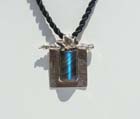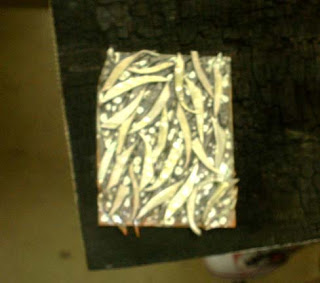I am learning this ancient technique in my jewelry and metalsmithing class at El Camino College. I purchased Linda Darty's book, The Art of Enameling, to bone up on some basic information. I really like the book, it is informative for the novice and intermediate enamelist. The book features several projects and lots of photographs. Enameling is an art form that takes time and patience to master, but there are many easy enameling projects that don't require a high degree of technical skill.
My assignment is to create a cloissonne pendant with an abstract landscape design. It only took me a second to decide on my subject. I had just witnessed the most extraordinary migration of whales along the peninsula. There were hundreds of blue whales feeding on the abundant krill as they make their way north. This sight was a miracle like no other. I decided to create a landscape of a whale spouting water in honor of this beautiful creature's migratory trek to the arctic.
For my project, I sketched out a design and colored it to show what it would look like enameled. The colored sketch will help me in my selection of enamels from a variety of test tiles. These are the steps I performed:
1) Clean copper plate. Apply scalex to one side, let dry. On the opposite side, fire with a clear flux. Clean edges between each firing.
2) Apply silver foil to plate, fire
3) Outline the sketch with cloissonne wire
4) Apply wires to plate with glue, fire
5) Clean transparent enamels by washing thoroughly
6) Mix enamels with a little 50/50 klyr fire/distilled water.
7) Apply enamels, fire; repeat twice
8) Abrade the surface of the piece with an alundum stone under running water. Even out surface.
9) One last firing to create a vitreous finish
 |
| Clear flux and cloissonne wires fired |
 |
| Fired piece before stoning |
My next step is to fabricate a setting for my piece. I designed a frame with a scalloped edge to give the effect of clouds around the upper half and line stamped around the lower half to create the idea of rays of light penetrating the water. To tie in the idea of the whale's migratory trek, I cut out small discs and stamped 'N' for north and 'S' for south on them. I formed two half-round circles of wire and soldered them to the discs. This entire piece was soldered around the outer rim of the bezel. The back of the piece has a tulle roller printed design that looks like a fishing net. After soldering the bail, I sanded, polished, oxidized then set the enameled piece. Here's my finished piece.
 |
| Northern Migration |
Learning is about doing and making mistakes. Each step needs to be thought out to ensure success in execution. I am happy that my finished piece conveys my idea and design. Now that I have some basic skills under my belt, my next piece should be even better. I guess we'll have to wait and see!































